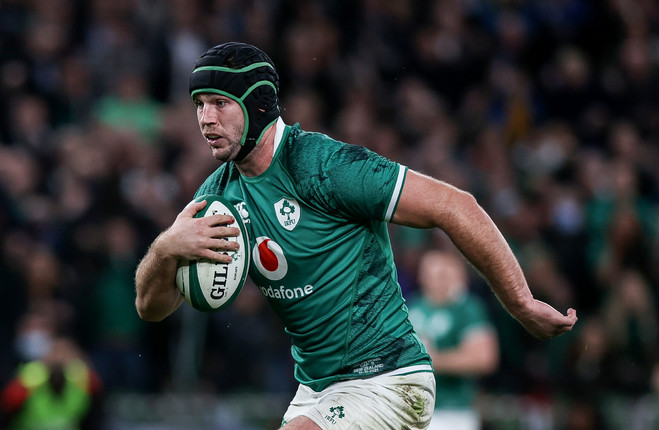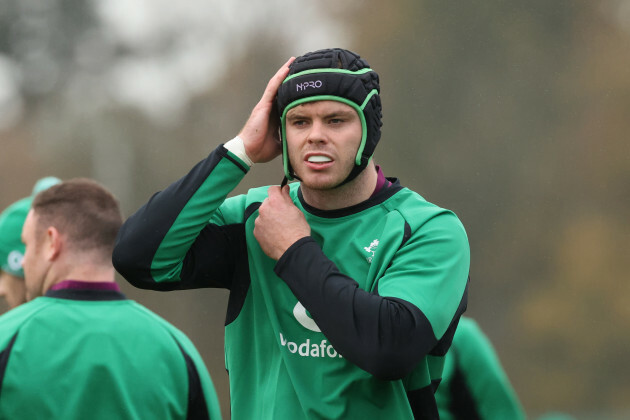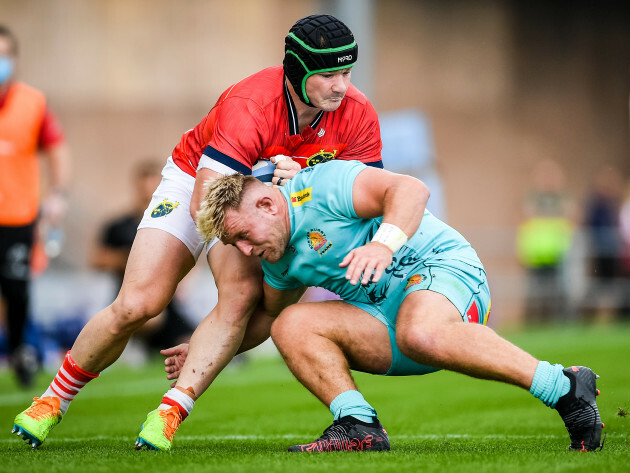WHEN IRELAND BACK row Caelan Doris was recounting his frightening experiences with concussion recently, he also highlighted that he has been wearing a new head guard since his return from a four-month period out of the game.
Doris said the N-Pro head guard “has a fair few studies behind it showing that it reduces the force to the head.”
He’s not the only professional using the N-Pro, which is produced by a Galway-based company founded by husband and wife duo, Mark and Dr Sandra Ganly.
Indeed, there are several others in Irish rugby and over 12o professional players in total now wearing it, while Cistercian College, Roscrea recently launched an initiative making it mandatory for first and second year rugby players in the school to wear the N-Pro.
N-Pro says its head guard can reduce impacts to a player’s head by up to 75%, meaning less G-force entering a player’s head, which is one of the big factors in brain injuries in sport.
This might be a bit jarring for those of us who have previously understood that head guards can’t make any difference with head injuries and concussion but Mark Ganly explains that the N-Pro is different.
Traditional head guards are mostly designed to protect against cuts, abrasions, and cauliflower ears, explains Ganly, and usually consist of three layers – an inner layer of fabric, outer layer of fabric, and one 10mm piece of foam in the middle.
The N-Pro has five layers and is made up of a unique material.
“They’re called viscoelastic foams,” says Ganly.
“If you squeeze an N-Pro, it’s soft. When the molecules are in a resting state, they’re soft.
“But if a force is applied – so when an impact comes to the head – momentarily, those molecules lock together. What they do is disperse that force out over a wider area rather than the force passing straight through. This all happens in a nano-second and the molecules then immediately go back to a released state again.
“That’s how we can give repeated impact protection. We have independent testing showing that if you take a traditional scrum cap, even after a single impact, their performance deteriorates because they cannot deal with that repeated energy.”
Ganly stresses that the N-Pro isn’t a “magic bullet” to prevent concussions and head injury but he hopes it can play a role in improving the situation.
“We’re like the crumple zone at the front of a car, rather than an NFL helmet which is like the bullbars on the front of a jeep, a rock-solid rigid surface. We’re like a crumple zone that slows down the momentum.
“We’re talking about tiny changes here but all of these repeated impacts over time is what is doing an awful lot of this damage to players.
“The big knock-out blows are a rare occurrence in rugby, it’s the repeated impacts that the players are constantly getting. We’re reducing those impacts as much as we can.”
N-Pro have published the results of their independent testing and studies in the BMJ Sport & Exercise Medicine and the Brain Injury journal, while the company has also done further testing with Ulster Rugby academy players and UCD’s cutting-edge computational model of the human brain, with those results yet to be published.
Mark Ganly originally studied IT and Telecoms in UL but was passionate about hurling and moved into sourcing and producing sports gear, including hurling helmets.
In 2010, Ganly was greatly impacted by reading about John Fogarty’s scary experiences with concussion and how it had impacted his life.
“I was well aware of head injuries in sport but what caught my eye was the human aspect of that when he was facing days in a dark bedroom and couldn’t face his wife or kids,” says Ganly.
Sandra Ganly has a PhD in biomedical engineering so when the couple spoke about Fogarty’s experiences, they wondered whether they could combine Sandra’s knowledge in clinical research and medical device innovation with Mark’s track record in sports products.
Three years of research and development later, they launched N-Pro in 2013. They’ve been working hard to build the company ever since and a recent funding boost of over €2million from the European Innovation Council has been welcome.
“There were 2,700 companies across Europe who applied,” says Ganly. “We’re one of five Irish companies to get it. It was a great endorsement for ourselves and a great endorsement for innovation in Ireland.”
They also had to convince World Rugby to allow the N-Pro to be used in rugby games as the design didn’t meet the governing body’s regulations around head gear. World Rugby hired external consultants to examine the research behind the product and it ended up with the announcement in early 2020 of a five-year trial for this kind of head guard.
World Rugby stated at the time that “it is important to note at the outset that World Rugby makes no claim as to the ability of the headgear devices to achieve the claims made by the manufacturers.”
As things stand, N-Pro is the only company that has fulfilled all the entry criteria for that World Rugby trial.
N-Pro have hired former Connacht player Sean O’Brien, who recently retired at the age of 25 due to concussion, as their ‘elite player manager.’ He speaks to professionals about the head guard but Ganly stresses that they don’t pay players to use the N-Pro.
“We have never paid anyone to wear the product, they’re wearing using it because of the impact protection gives them and they’re happy with the product.
“We took a decision right from day one that if a player wanted to be paid to wear it, good luck. We want people wearing it for the right reasons.”
N-Pro tracks injury data for every single pro player using the head guard and while Ganly says it’s too early to reveal those figures, “we’re seeing a dramatic reduction in head injuries in our group as compared to other professional groups.”
He adds that word of mouth within the pro ranks has proven powerful.
“Some of the pro guys who wear the product have become huge advocates of it because you’re seeing the benefits of it.”
O’Brien – an alumnus of Roscrea – is also helping N-Pro to spread the word in the grassroots game, which Ganly says is just as important. The Ganlys have three sport-playing children and appreciate the concerns some parents have about head injuries in rugby.
Brendan McKeogh, Roscrea’s director of sport, said there was a “very positive” reaction among parents when the school sent out the studies behind N-Pro, with many of them worried about concussion and also a lack of experience with contact sports.
“10 years ago, you would rarely have got a child who came to the school without having played team sports whereas now, that’s becoming a little more common,” said McKeogh.
“You can occasionally get parents who don’t want their child to play rugby and we think it’s partly due to the discussion in this area. We’re hoping that if parents can see that there is an added layer of safety with the N-Pro, and that players are looked after, that’s what we’re trying to address.
“One parent told us that if it prevents their son from getting one concussion, it’s worth it.”
For now, only first and second years have to wear the N-Pro but it’s available to all other students in the school. The 23-day sit-out period still applies for anyone who sustains a head injury in schools rugby and Roscrea will continue to track injury data for every player.
“We also have to recognise that this isn’t an automatic deterrent against any concussions,” said McKeogh, “but it is hopefully going to reduce head injuries.”
Ganly is keen to stress this point too. The N-Pro isn’t some overnight cure for the dangers of playing rugby.
“What we always say is that N-Pro isn’t a magic bullet that’s going to fix things on its own,” says Ganly.
“It’s part of the solution along with better tackle technique, better education, and awareness.”
There is plenty more research and study ahead for N-Pro, with a major project launching next year whereby they will track a large group of players’ blood biomarkers and more data in the hope of showing the head guard’s positive impact on head injuries.
Ganly also sees a future for the N-Pro outside of rugby.
“The technology can be transferred into any sport,” he says. “We’re looking at sports like soccer – where there are great concerns over head impacts – so while we’ve designed it to be used in rugby, it has already been used in multiple sports.”



